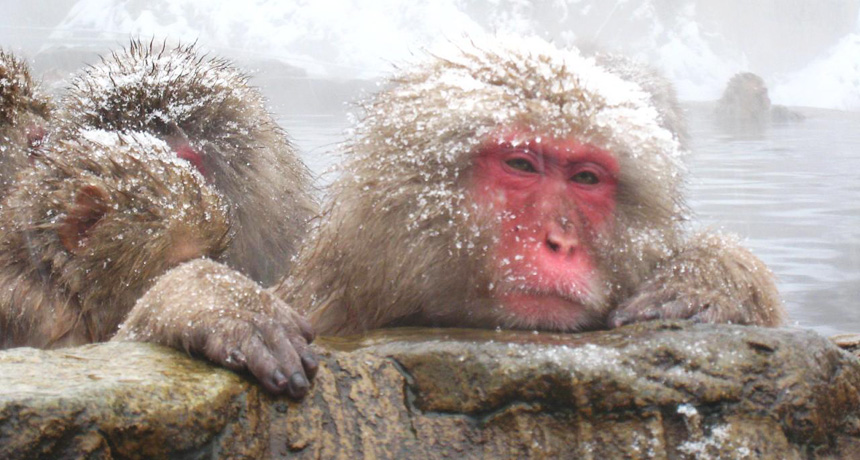Eight ways that animals survive the winter

Japanese Macaques at the Jigokudani Monkey Park in Japan’s Nagano prefecture keep warm through the winter by taking dips in the hot springs.
Wajimacallit/Flickr
- More than 2 years ago
A dip in the polar vortex brought sub-freezing temperatures to much of the United States again this week. And although this type of weather can be deadly, modern humans have largely figured out how to survive the cold, snow and dark that come with winter. We’ve got heated homes filled with bright lights. We bulk up with thick sweaters and down-filled coats. And if all that isn’t enough, we can jet off to warm, sunny locations. Animals may not have access to Gore-Tex, but they’ve got lots of lessons for dealing with the wintery conditions. Here are eight methods for keeping warm and surviving winter used by the animal world (and many of us):
Take a warm soak
At Jigokudani Monkey Park in the Nagano prefecture of Japan, Japanese macaques (also known as snow monkeys) can be viewed bathing in the hot springs. The behavior is seen more often among dominant macaques than subordinate ones, researchers reported in the American Journal of Primatology in 2007. It’s also more common in the winter than in the summer, so it’s likely that the monkeys really are using the hot baths to warm up.
Migrate to warmer environs
When the temperature starts dropping outside, this method of dealing with winter begins to look more and more attractive. No wonder that so many different types of animals take this route, from birds to monarchs (and even human snowbirds). But that doesn’t mean it’s an easy life choice. Alpine swifts, for example, breed in Switzerland in summer, then migrate to West Africa for the winter. The birds don’t necessarily stop in Africa, though. Swifts outfitted with tiny flight recorders stayed aloft for as many as 200 days, more than six months in the air without a touchdown, Jessica Shugart reported last year in Science News.
Hide out under the snow
It may have to be cold for it to snow, but snow acts as an insulator, keeping out the worst of the cold (which is why igloos were invented). Whole ecosystems can be found living in that space between the snow and the ground, a type of ecosystem that some ecologists last year named the subnivium. Invertebrates, small mammals, reptiles, amphibians and even birds hide out in this warmer region, living off the vegetation they find there.
Use antifreeze
Wood frogs (Rana sylvatica) are found across much of North America, from Georgia to Alaska. The Alaskan frogs, though, have to deal with much colder temperatures; the average January low they experience is ‑28° Celsius. To survive the freeze, the frogs have higher levels of sugar, urea (a urine waste product) and a third as-yet-unidentified chemical that together act like an antifreeze, lowering the temperature at which the frogs turn into frogsicles, Meghan Rosen reported in Science News last year.
Stock up for the winter
We’ve all seen squirrels burying nuts to prepare for the winter. This can be an important adaptation for creatures that don’t sleep through the dark and cold months. Pikas, small mammals found in western North America, are also hoarders. But the pika’s bigger problem is probably how the animal will adapt to warmer weather brought about by climate change. The pika, it seems, is more at risk of overheating than freezing. One population of pikas living in the Columbia River Gorge of Utah has managed to make it through warmer weather by eating moss. The moss isn’t very nutritious, though, so the pika gives its digestive system a second chance at extracting nutrients by eating its own poo, Bethany Brooskshire recently reported on the Eureka!Lab blog.
Slow down
The key to hibernation isn’t sleep — it’s the conservation of energy. Red-eared sliders have so mastered that feat that scientists thought they slipped into a coma when winter came. The freshwater turtles may not take a breath for weeks, but they’re still conscious enough to notice light peeking through from above. That’s just hibernation, not a coma. “In the wild, as ice finally cracks, light streaming through could signal to turtles that it’s time to swim up for a breath of air,” Susan Milius reported in Science News last year.
Adapt to the darkness
Some reindeer live north of the Arctic Circle, which means that for at least part of the year their days have no natural light from the sun. But these animals have a couple of methods for helping them see: Their eyes can detect ultraviolet light, which helps when conditions are dim. And one part of a reindeer’s eye, the tapetum lucidum (the layer of tissue behind the retina that reflects light) can change color, shifting from golden in the summer to blue in winter, which increases the eye’s sensitivity.
Huddle together for warmth
Sharing body heat is a great way to conserve energy and keep out cold, but emperor penguins in Antarctica have mastered this technique — and they do it with an egg balanced on the feet. It turns out, though, that there’s an optimal distance for huddling, with the birds only touching slightly so they don’t compress their feathers and compromise their insulation. And if one bird takes a step and gets too close, the next penguin takes his own step, setting off a wave of motion through the huddle, similar to the way cars move in a traffic jam, researchers reported last month.





